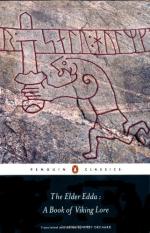|
This section contains 274 words (approx. 1 page at 400 words per page) |

|
Elder Edda Summary & Study Guide Description
Elder Edda Summary & Study Guide includes comprehensive information and analysis to help you understand the book. This study guide contains the following sections:
This detailed literature summary also contains Bibliography and a Free Quiz on Elder Edda by Anonymous.
The Elder Edda is not a single continuous narrative, but a collection of poems, most of which are preserved in the Konungsbók, or Codex Regius (King's Book), copied in Iceland about A.D. 1270. The poems are the work of many poets. Their language suggests that they were composed between 800 and 1100 A.D. and first written down between 1150 and 1250 A.D. The poems are a rich source of information for culture and belief among the Vikings. They are not, however, purely Scandinavian. Christian Irish influence is likely, while the Sigurd story draws on actual events among the tribes that invaded the Roman Empire between 350-600 A.D.
The Elder Edda first came to scholarly attention in the seventeenth century as antiquarian interest in the non-classical past was growing in Europe. It was published in its entirety just as intense romantic and nationalistic interest in the perceived tribal ancestors of the European nation states emerged towards the end of the eighteenth century. This interest, combined with the new science of philology, ensured popular and scholarly interest in texts like the Elder Edda. Some of the lays were available in bowdlerized versions even for children by the later nineteenth century. In the hands of Richard Wagner, the Elder Edda became the foundation of one of the century's masterpieces. While northern legends and the scholarship based on it were misused by the Nazis to develop and further their ideas of race, they are seriously misrepresented by such ideas. In the 1960s, the poet W. H. Auden in collaboration with an Old Norse scholar, Paul B. Taylor, produced a translation of sixteen of the poems.
Read more from the Study Guide
|
This section contains 274 words (approx. 1 page at 400 words per page) |

|



